
table of contents
- Meadow flower very adaptable
- Types from A - F
- Types of G - H
- Types of K - S
- Types from T - Z
- frequently asked Questions
There is an infinite variety of wild-growing meadow flowers. Nature has a lot to offer here. It is often difficult for the layperson to correctly recognize individual species and differentiate them from one another. Here we introduce you to 23 white meadow flowers.
In a nutshell
- white meadow marguerite, the most common meadow flower
- Wildflowers attract insects
- Meadow flowers in fields too. Fields, wasteland and roadsides
Meadow flower very adaptable
Meadow flowers are often referred to as "weeds" because they grow in meadows, fields and fields between the actual cultivated plants. They can also be found on wasteland, on roadsides or rubble heaps. There they shine in a wide variety of colors and attract insects.
Types from A - F
UmbellateMilky Star (Ornithogalum umbellatum)
Doldy Milky Star

- Flowering period: April to May
- Growth habit: herbaceous, spherical onion
- Height: 10 to 30 cm
- Blossom: Cone cluster of 10 to 20 flowers, green stripes on the underside
- Leaves: basal, linear, white central stripe
- Stem: upright
- Special features: often cultivated in gardens
Note: The bulb of this meadow flower is poisonous for humans and animals.
Real chamomile (Matricaria chamomilla)
Maiden flower, feverfew
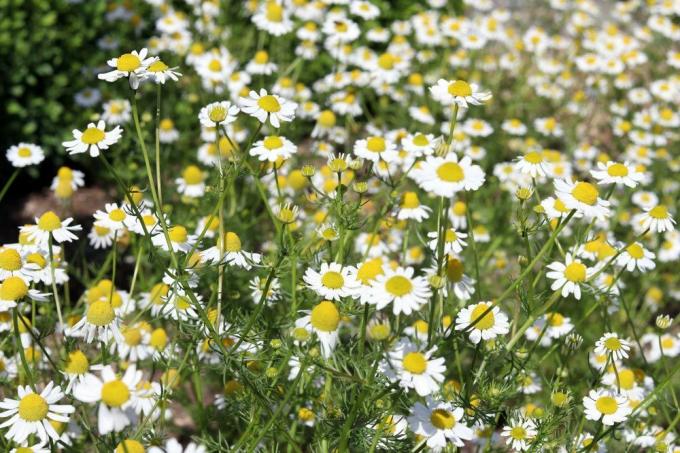
- Flowering period: May to August
- Growth habit: herbaceous, annual
- Height: 15 to 40 cm
- Blossom: loose umbels, yellow disk, outside white ray-florets
- Leaves: sessile, 3 to 5 cm long, lanceolate, pinnate
- Stem: glabrous, upright, often branched
- Special features: fragrant
- Confusion: odorless beach chamomile "false chamomile" (M. inodorum)
Annual fleabane (Erigeron annus)

- Flowering period: July to October
- Growth habit: herbaceous, annual
- Height: 50 to 100 cm
- Blossom: loose panicles, yellow disk, outside white ray florets
- Leaves: lower leaves stalked, lanceolate, edge serrated, upper leaves sessile
- Stem: erect, hairy, richly branched
Types of G - H
Daisies (Bellis perennis)
Dimensional sweetheart, darling
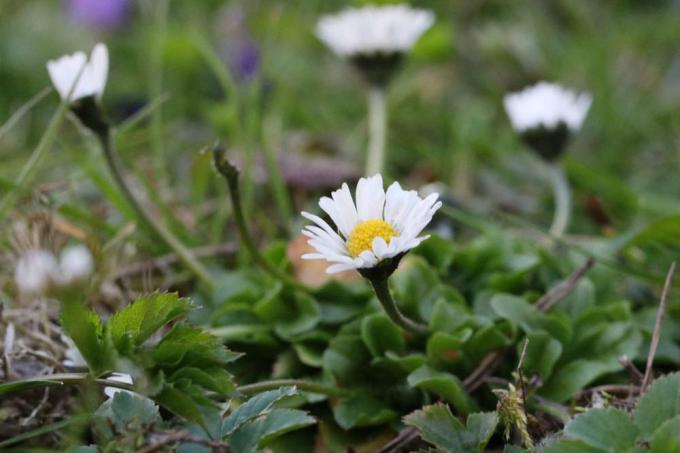
- Flowering period: February to November
- Height: 5 to 15 cm
- Growth habit: herbaceous, bushy, persistent
- Blossom: 2 to 2.5 cm in diameter, yellow disk, white ray florets on the outside
- Leaves: 0.5 to 4 cm long, dense basal rosette, obovate
- Stem: slightly hairy and leafless
Common yarrow (Achillea millefolium)
Field yarrow, field yarrow

- Flowering period: June to October
- Growth habit: herbaceous, persistent, horizontal rhizomes
- Height: 15 to 50 cm
- Flower: 4 to 5 mm wide flower heads, dense umbels
- Leaves: elongated, lanceolate, pinnate, stem leaves sessile
- Stem: erect, grooved, slightly hairy
- Special features: slightly aromatic scent
Common usury flower (Leucanthemum vulgare)
Meadow Marguerite, White Excessive Flower
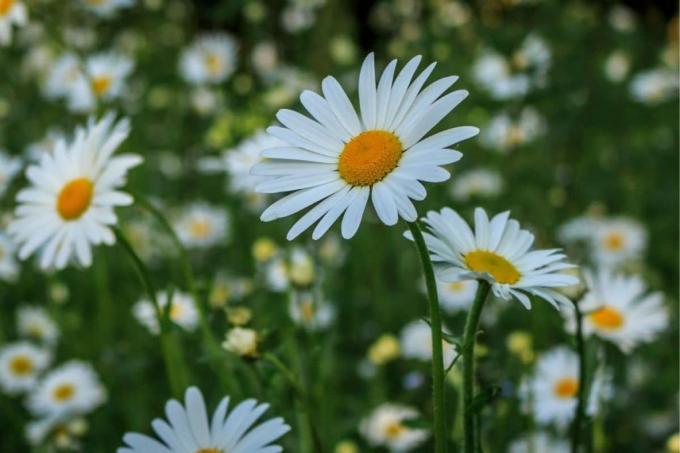
- Flowering period: June to October
- Growth habit: herbaceous, persistent
- Height: 20 to 50 cm
- Flowers: 4 to 6 cm wide flower heads, yellow flower discs, outside white ray florets
- Leaves: lower leaves stalked, elongated lanceolate, upper leaves sessile or encompassing half-stems
- Stem: erect, simple or branched, base slightly hairy
Common catchfly (Silene vulgaris)
Pigeon goiter
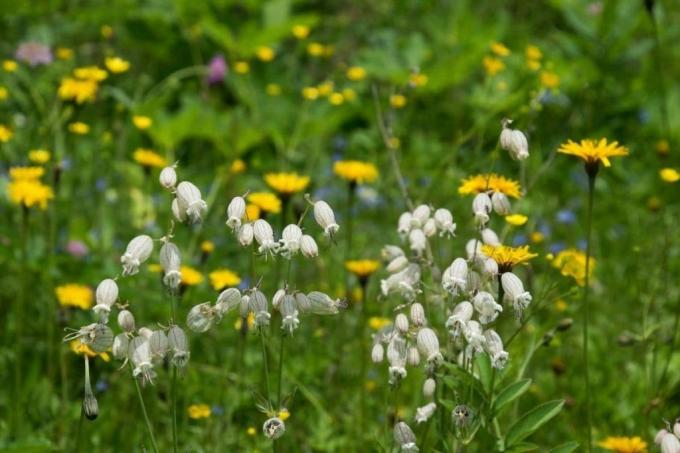
- Flowering period: June to August
- Growth habit: persistent
- Height: 20 to 50 cm
- Blossom: long-stalked, nodding, loose panicles, spherical, inflated calyx
- Leaves: linear, lanceolate, sessile, opposite, bluish-green
- Stem: erect or ascending, glabrous or slightly hairy
Grass Lily (Anthericum liliago)
Sessile grass lily, branchless grass lily

- Flowering period: May to June
- Growth habit: herbaceous, perennial, rhizomes
- Height: 30 to 60 cm
- Flowers: 10 to 20 lily-like flowers, loose, racemose inflorescences
- Leaves: up to 40 cm long, linear, basal
- Stem: upright, smooth, unbranched
- Special features: loves sunny, dry meadows
- Confusion: knotty grass lily (A.ramosum)
Autumn Wendelorchis (Spiranthes spiralis)
Autumn rotating ear, screw stand
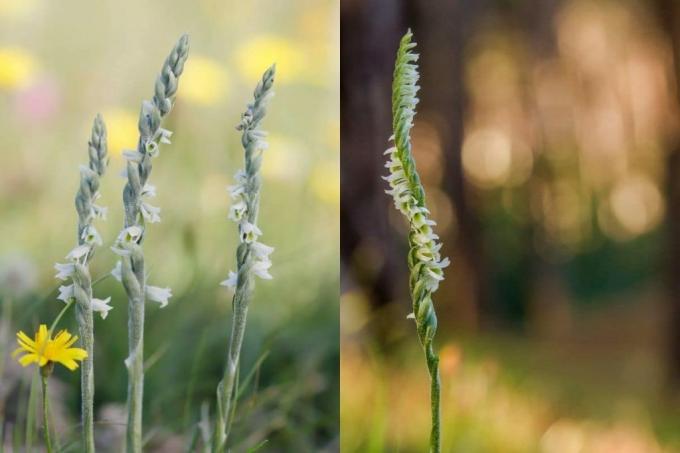
- Flowering period: August to September
- Growth habit: herbaceous, two underground tubers
- Height: 10 to 30 cm
- Blossom: unitary, screw-like inflorescence, 25 individual flowers, lip slightly greenish on the inside
- Leaves: lateral rosette at stem base, 3 to 6 oval lanceolate leaves
- Stem: upright, slender, without leaves
- Special features: weak scent of vanilla
Note: This meadow flower is under strict protection. It occurs in southern Saxony-Anhalt, in the Franconian Jura, on the Frankenhöhe, in the Alpine region and in the foothills of the Swabian Alb.
Types of K - S
Little meadowsweet (Filipendula vulgaris)
Tuberous meadowsweet, tuberous perennial

- Flowering period: May to July
- Growth form: bulbous, thickened, woody rhizomes
- Height: 30 to 80 cm
- Flower: short-stalked, terminal, cymes
- Leaves: basal rosette, stalked, up to 40 cm long
- Stem: upright, somewhat branched
Note: This meadow flower is mainly found in damp meadows.
Carrot (Daucus carota)
Wild carrot, Common carrot
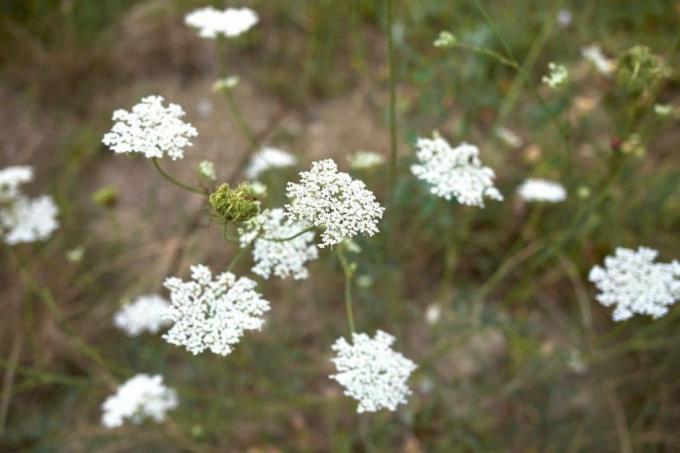
- Flowering period: June to September
- Growth habit: herbaceous, biennial, thick roots
- Height: 30 to 100 cm
- Blossom: dense, flat umbels, reddish to black "carrot blossom" in the middle
- Leaves: lanceolate, pinnate, toothed edge
- Stem: erect, furrowed, hairy, upper part branched
Nodding catchfly (Silene nutans)
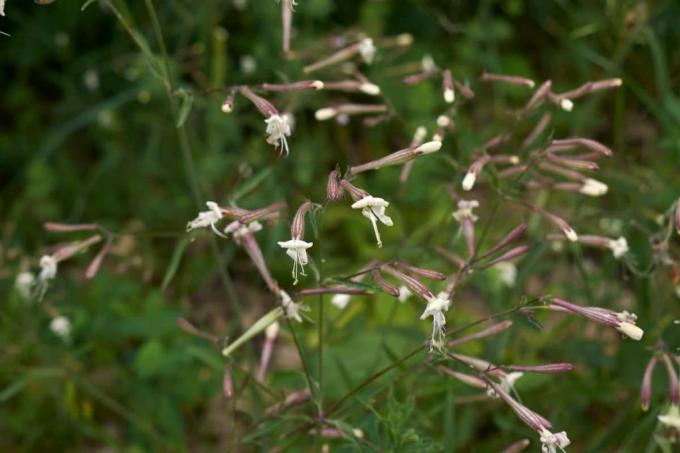
- Flowering period: May to August
- Growth habit: herbaceous, persistent
- Height: 30 to 80 cm
- Blossom: nodding panicle blossoms, brown-violet calyx with glandular hairs, 5 two-part petals
- Leaves: standing in rosettes, slightly tomentose, lanceolate
- Stem: simply ascending, pubescent at the base, sticky
Note: The flowers of this meadow flower only open in the evening and give off a pleasant scent.
Snowdrop (Galanthus nivalis)

- Flowering period: February to March
- Growth habit: persistent, oval black-brown onion
- Height: 10 to 30 cm
- Flower: nodding single flower, green spot at the lower end
- Leaves: linear, flat, up to 20 cm long, in pairs
- Stem: upright
- Special features: preferably poor meadows, alluvial forests
Silver thistle (Carlina acaulis)
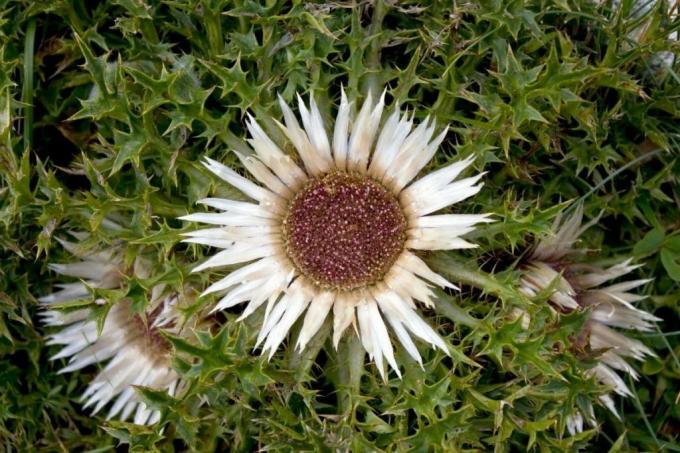
- Flowering period: June to September
- Growth habit: perennial, tap root
- Height: 5 to 30 cm
- Flowers: baskets with brownish tubular flowers, elongated, shiny bracts form a wreath, white and silver
- Leaves: leaf rosette, low-ply with piercing tips
- Stem: almost stemless
- Special features: protected!
Swamp heart leaf (Parnassia palustris)
Student roses
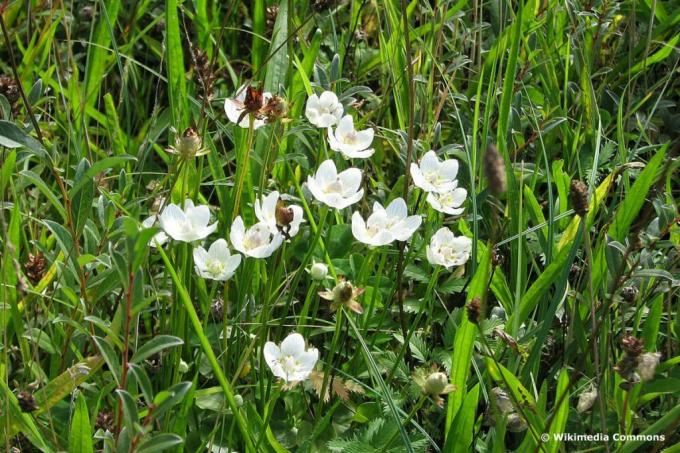
- Flowering period: June to August
- Growth form: short, branched rhizome
- Height: 10 to 30 cm
- Flower: single flowers, terminal, 5 petals, brownish veined
- Leaves: rosette-like, short-stalked, ovoid to heart-shaped
- Stem: upright
- Special features: preferably wet meadows, boggy soils
Types from T - Z
White light carnation (Silene alba)
White night carnation

- Flowering period: May to September
- Growth habit: biennial, herbaceous
- Height: 30 to 100 cm
- Blossom: terminal, pear-shaped, bulbous calyx, secondary crown in the throat, 5 petals
- Leaves: smooth-edged, lanceolate, up to 10 cm long
- Stem: forked, branched, hairy upper part
- Special features: Night bloomers, pleasantly fragrant
White daffodil (Narcissus poeticus)
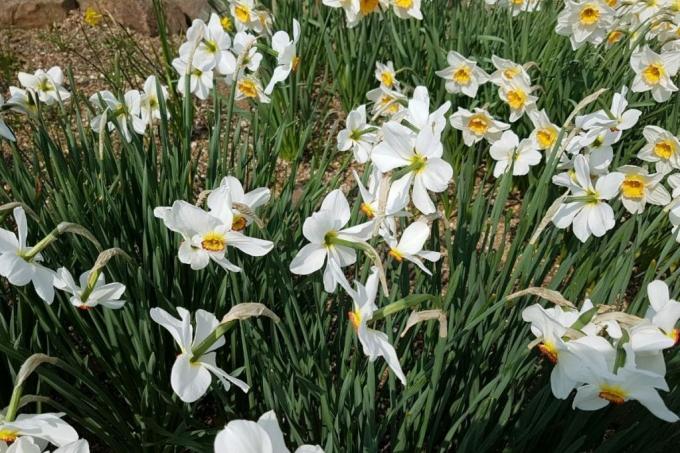
- Flowering period: April to May
- Growth form: oval, underground onion
- Height: 20 to 30 cm
- Flowers: single flowers, 4 to 5 cm in diameter, white bracts. central yellowish-white corolla, bordered orange-red
- Leaves: 2 to 3 pieces, linear, gray-green
- Stem: upright, brownish, membrane-like sheath at the base
- Special features: intensely fragrant
- Confusion: Narcissus radiiflorus
Willow oak (Plantago media)
Middle plantain
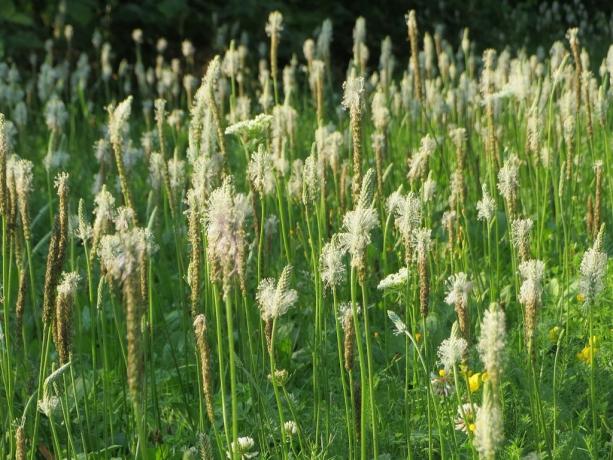
- Flowering period: May to July
- Growth habit: herbaceous, persistent
- Height: 20 to 40 cm
- Flower: cylindrical flower spike, silver-white crown, purple-colored stamens
- Leaves: basal rosette, velvety hairy, elliptical
- Stem: upright
White clover (Trifolium repens)
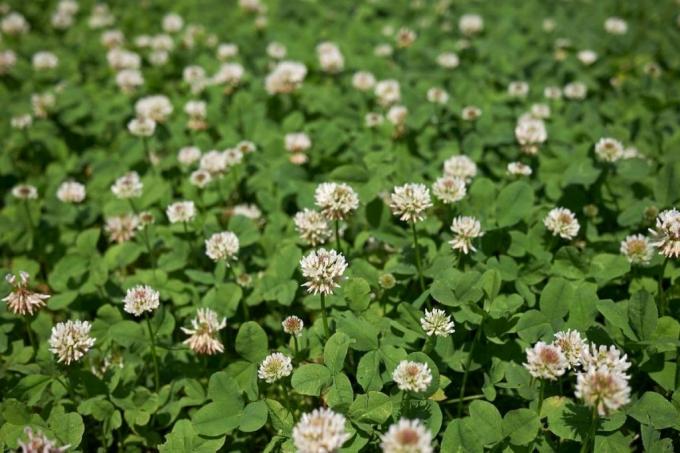
- Flowering period: May to September
- Growth habit: perennial, bald, creeping runners
- Growth height: 10 to 20 cm
- Flowers: dense, spherical, terminal
- Leaves: long-stalked, obovate, three-leaved, whitish markings in the center
- Stem: creeping
Meadow hogweed (Heracleum sphondylium)

- Flowering period: June to October
- Growth habit: herbaceous, strong rhizomes
- Height: 30 to 150 cm
- Flower: compound umbel, 5 petals, enlarged marginal flowers, numerous bracts
- Leaves: lobed to pinnate
- Stem: furrowed, bristly hairy
Meadow bedstraw (Galium mollugo)
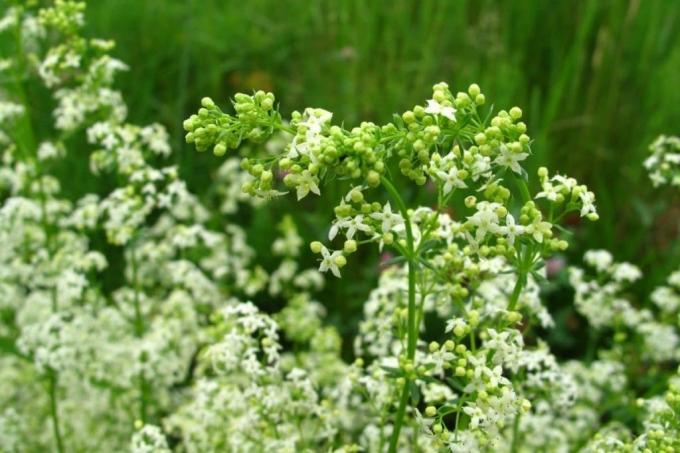
- Flowering period: May to September
- Growth habit: herbaceous, long subterranean runners
- Height: 25 to 100 cm
- Flower: pyramidal panicle, many small flowers, flower diameter 2 to 3 mm
- Leaves: linear, light green, leathery, 6 to 8 leaves arranged in whorls
- Stem: square, mostly branched
Note: The roots of this meadow flower contain red dye. It used to be used for dyeing.
Meadow Chervil (Anthriscus sylvestris)
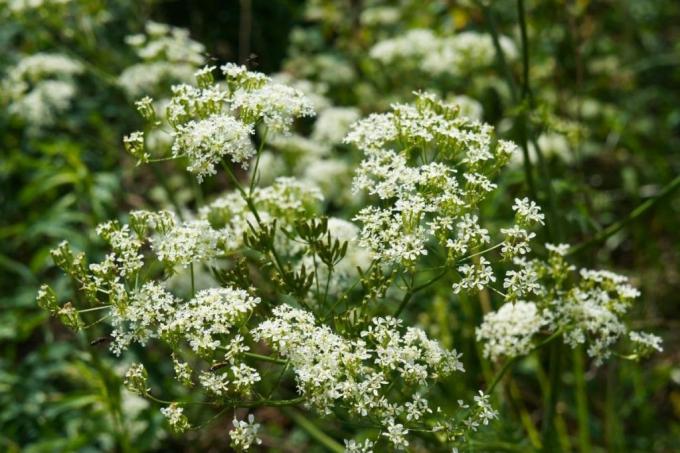
- Flowering period: April to July
- Growth habit: herbaceous, perennial, sometimes biennial
- Height: 50 to 130 cm
- Flower: small, 7 to 10 rayed, umbrella-shaped umbels, surrounded by bracts
- Leaves: long-stalked, pinnate, oval-lanceolate
- Stem: grooved, upright, hollow
- Special features: sharp, aromatic smell
Meadowfoam (Cardamine pratensis)
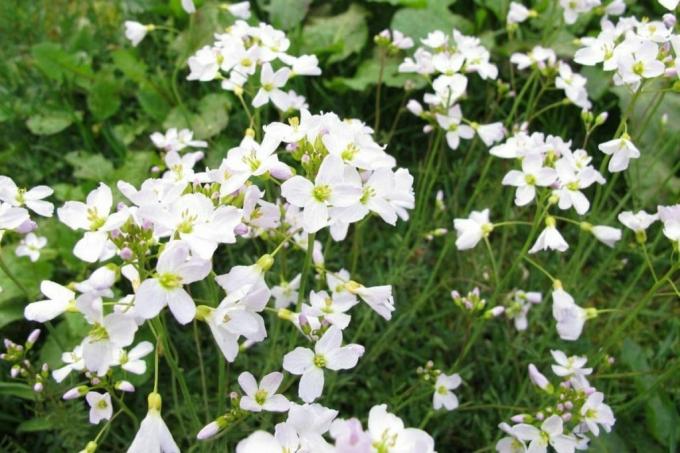
- Flowering period: April to July
- Growth habit: herbaceous, bulbous, thickened rhizome
- Height: 15 to 60 cm
- Flowers: corymbs, four petals white to pink, four green sepals
- Leaves: rosette, basal, unpaired, pinnate
- Stem: upright, hollow, base slightly hairy
- Special features: often piles of foam on the stem, prefers moist meadows
frequently asked Questions
No. However, among them there are orchids or orchid-like plants. These are mostly rare and are under nature protection. They must not be picked or dug up.
Yes. Seeds for native wild and meadow flowers are available from specialist shops. These are mixtures of flowers. This creates magnificent, colorful flower meadows. These attract a wide variety of insects. Some meadow or Wildflowers are already cultivated in the garden like snowdrops or umbellate milk star.
It may only contain native wild flowers, no breedingly modified varieties and no grasses. Furthermore, a precise indication of the species contained and the respective quantities should be shown on the label.

